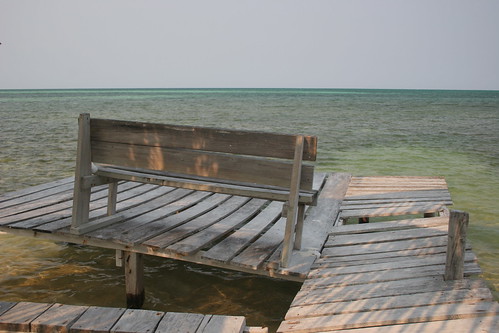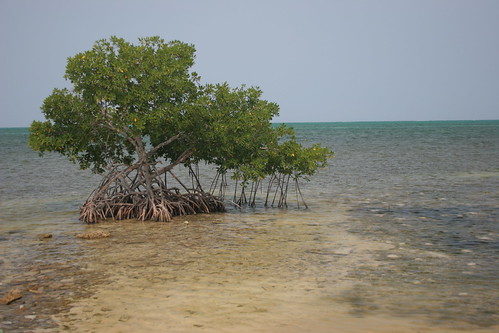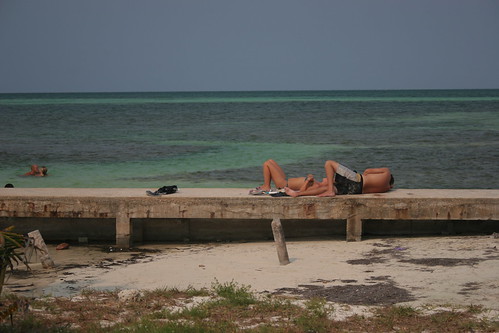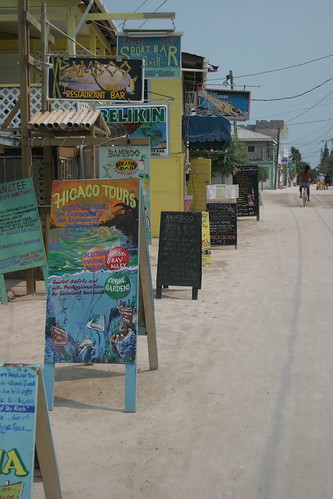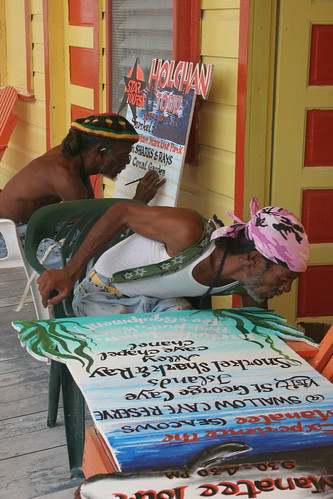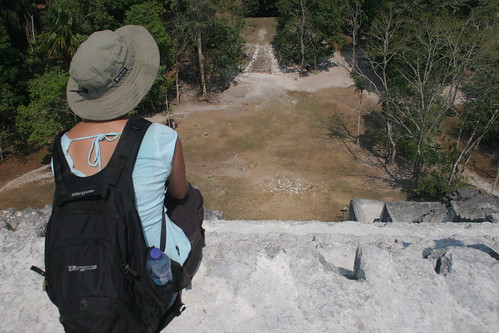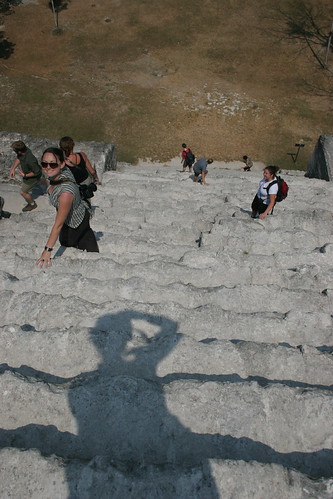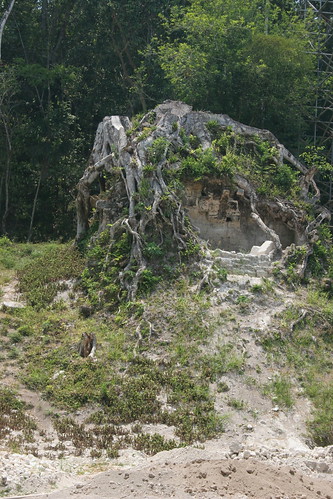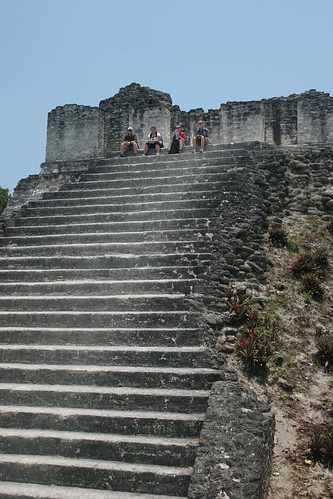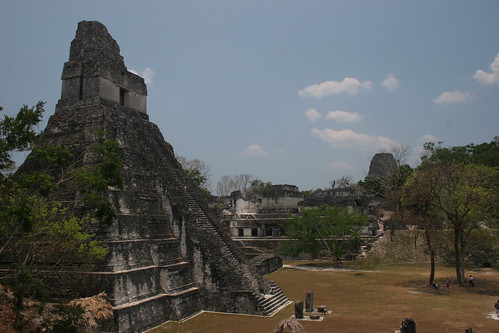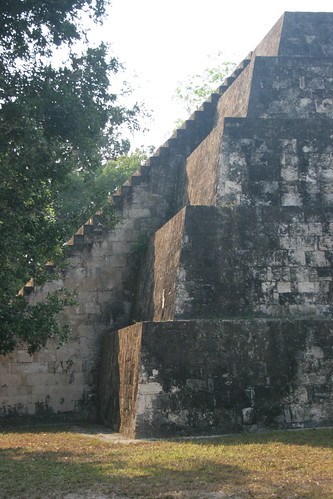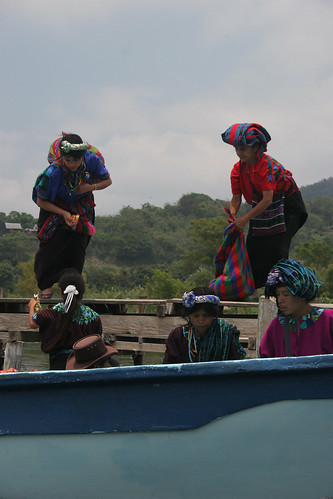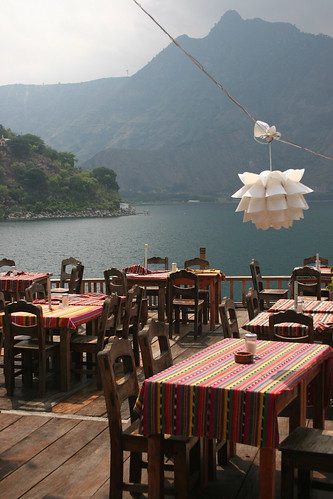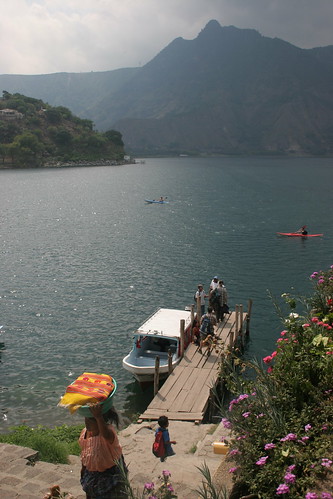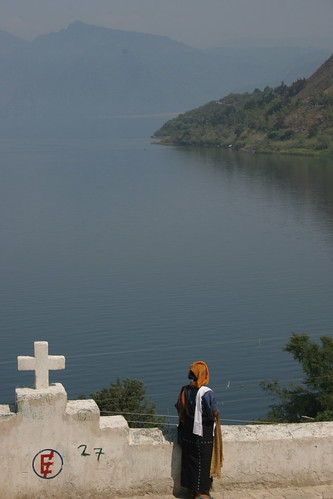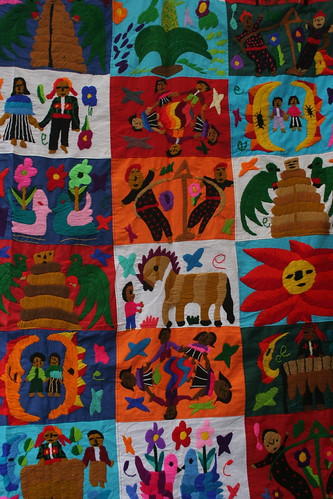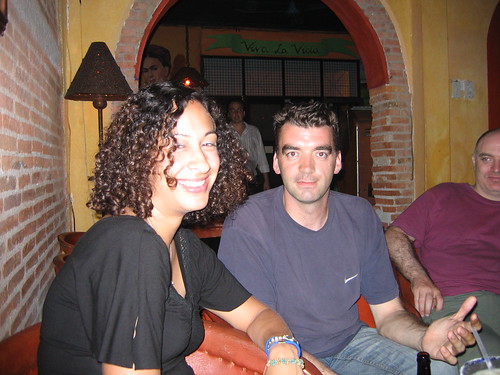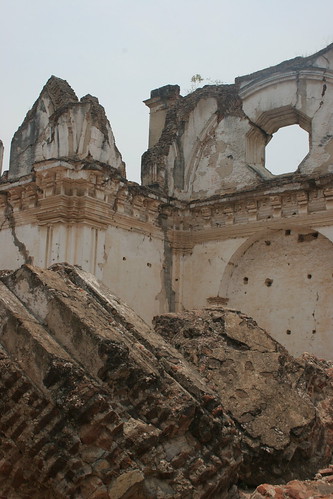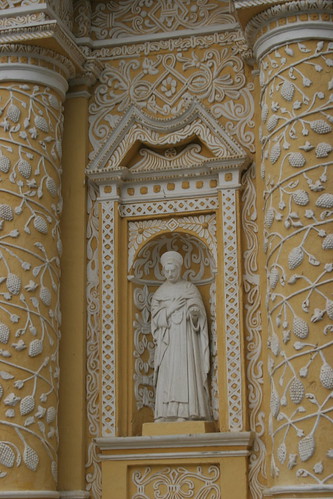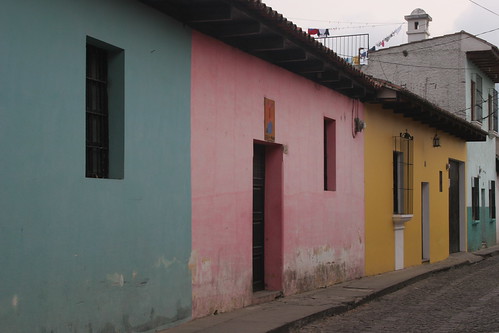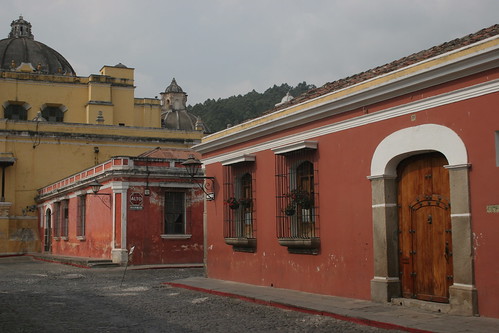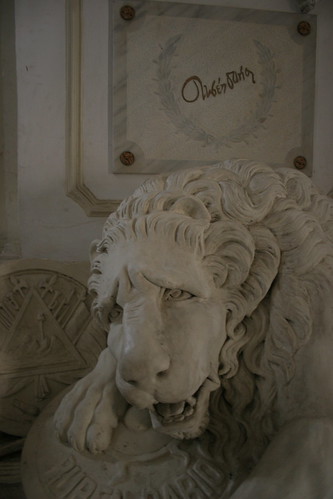Saturday, May 26, 2007
Caye Caulker, Belize
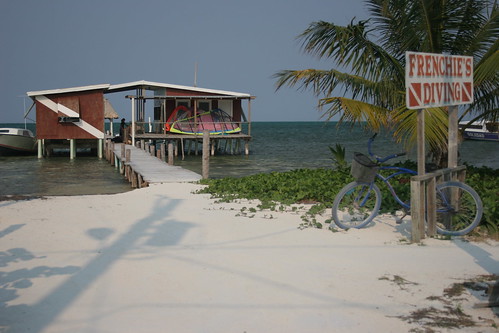
Everyone is keen to snorkel with rays and sharks (mainly rays) so we've hired a small wooden boat garishly-painted in purple, orange and green to take us out to the reef, which is the second longest after the Great Barrier Reef. The crew are a bunch of cool dread-locked dudes brandishing deep battle scars. With reggae music and rum cocktails in hand we head out on the shallow green waters.
In chest-high water a swarm of stingrays circle us brushing past me as they swim by. They appear to like human touch. Instead of avoiding the many human legs in the water, they slide their bodies over my ankles. Their undersides are smooth, a bit like squid. I like the feeling although I'm afraid of stepping on one.
I'm disappointed not to see a shark but one of the crew spots one from the boat and asks me to jump in. I do and although it doesn't let me get too close, I can see the unmistakable dark shadow of a (nurse) shark loitering by a rock. Amazing. Unfortunately my underwater camera leaked so I lost all my photos.
Caye Caulker, Belize

After a two hour bus ride to Belize City and an hour in a water taxi we arrive at Caye (pronounced 'key') Caulker, as island off the Caribbean coast. It reminds me a little of Utila in Honduras with its laid-back, can't-be-arsed mentality. In fact the motto here is 'slow down'. Not really possible unless you were dead.
Like Utila chilled-out reggae tunes fill the air. Locals and tourists alike amble down the dusty beach road to swim, snorkel or dive as, like Utila, there isn't a lot else to do. The big diving attraction here is the Blue Hole, a large sinkhole in Lighthouse Reef about 122 metres deep. Divers descend to 40 metres and swim beneath a stalactite-laden overhang among a variety of sharks. I'd love to do this but it's only for advanced or experienced divers. Instead I opt to snorkel with (hopefully) sharks and rays.
(Photo - view from the hotel)
Aktun Tunichil Muknal, Belize

At the back of the Cathedral Chamber there's a ladder leaning on the cave wall. One after the other we climb to the top and make our way down the cave ledge. Roped off at the back there is an intact skeleton of a young Mayan girl believed to be a human sacrifice.
We return the same way we came in. The water appears to be deepe on the way back as I find myself having to swim more often. We hardly say a word on the way back. The experience has been truly amazing.
Aktun Tunichil Muknal, Belize
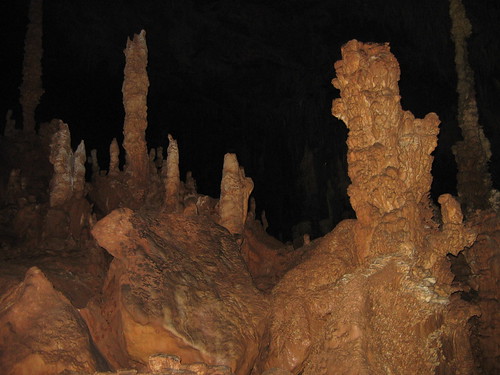
After an hour we climb up one of the precarious cave sides onto a dry ledge. Here we're asked to remove our sodden shoes and continue with socks. The guide begins a convoluted story of twins, Mayan gods and reincarnation. Looking around I see everyone with confused expressions so it's not just me. What I did glean was that Mayans believed caves were the portal to the underworld.
We continue our ascent through the cave passing ceramic pottery, artifacts and human skulls left by Mayans 1400 years ago as offerings to the gods until we reach the Cathedral Chamber, a huge cavernous space as large as a church hall, overhung with the most enormous intricate stalactites and stalagmites.
Aktun Tunichil Muknal, Belize
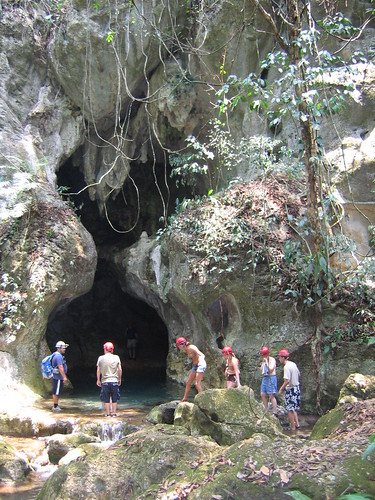
Since Caverna Santo Tomás in Cuba, I'm worried that no caving experience will come close but this one comes highly recommended.
The Mayan Aktun Tunichil Muknal (Cave of the Stone Sepulchre) was only discovered in 1986 and opened to the public in 1997. Located 1.5 hours from San Ignacio, it's a 45 minute hike through semi-tropical forest to reach the cave entrance. The entrance is an elongated slit in the limestone karst over a deep pool of clear aquamarine water. To enter the cave we need to swim across the pool. Exciting.
We're given hard hats with head lamps, and dressed in swimsuits, t-shirts and shoes we plunge into the shimmering pool and start to swim. The water is icy cold and takes my breath away.
Into Belize
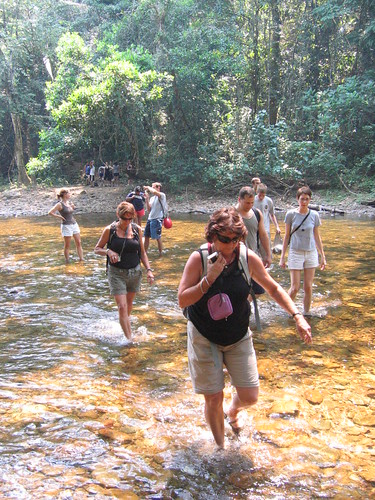
It's three hours to Belize. The border crossing is the easiest so far in that we don't even need to get off the bus.
I'm not sure what to make of Belize. It can't seem to decide whether it's Caribbean or Latin American. Everyone speaks English with a strong Caribbean accent but with creole words I don't understand. The currency, Belizean dollars, also has the queen's face printed on one side. San Ignacio, where we're staying, is a slow-paced dusty town teeming with backpackers and locals sitting around. There is definitely a lazy feel to Belize. No one it seems can be bothered.
(Photo - Walking to the Aktun Tunichil Muknal Cave)
Temple V, Tikal, Guatemala
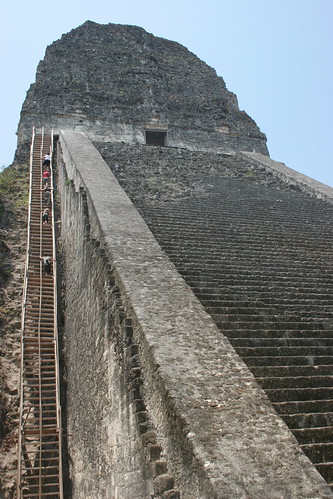
Hot and steamy Tikal's central area is spread out over 16 sq km with over 4000 structures concentrated in sections around the Great Plaza, Central Acropolis, South Acropolis and Temple V, Plaza of the Seven Temples, El Mundo Perdido and Temple IV and Complex N. The steep temples, most of which you can climb, rise to heights of more than 44 metres affording spectacular views. Some are climbed via the steep steps and others via ladders (Temple IV - the highest building at 64 metres). From the top I can see the vast jungle canopy stretching out as far as the eye can see, interrupted only by the odd temple poking through.
(Photo - Climbing Temple V, the second highest pyramid in Tikal at 58 metres)
Tikal, Guatemala
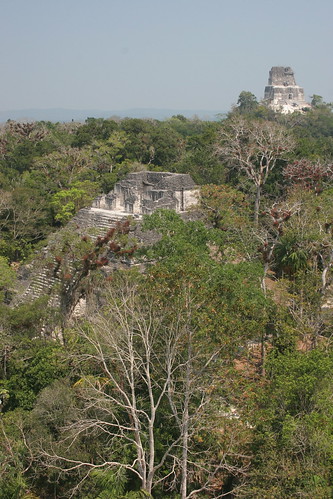
It's five hours on the bus to Flores, a small island on Lago de Petén, connected to the Guatemalan mainland by a causeway. While pleasant enough most only people stay here as a jump off point to Tikal, the largest excavated Mayan ruins - or the 'mother of all ruins' as described by my guidebook.
Tikal is amazing. Giant towering pyramids pierce the dense rainforest canopy, filled with toucans and howler monkeys. Tikal is different from Copan, Chichen Itza and most other Mayan sites because it's buried deep in the jungle.
(Photo - view from the top of Temple IV)
Cueva de la Vaca, Rio Dulce, Guatemala
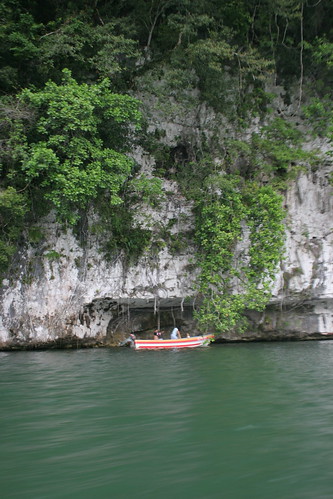
In the afternoon we catch the boat to Livingston, a strange Caribbean town on the mouth of the river, seemingly full of drunks and oddballs. There's not much to see in Livingston but the boat ride through Cueva de la Vaca, a steep-walled gorge hung with great tangles of jungle foliage and bromeliads is stunning. On the way we also pass through river inlets teeming with mangroves and water lilies.
Aguas Calientes, Rio Dulce, Guatemala
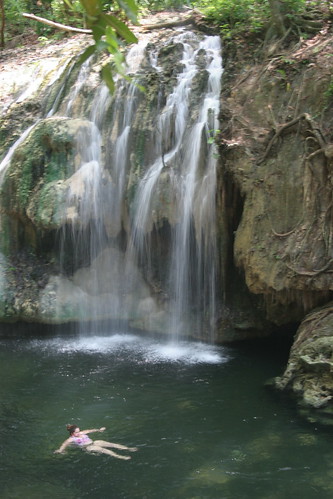
In the morning we take a boat to some hot springs, Aguas Calientes, a 40-minute walk from Finca El Paraíso. The pool is a beautiful spot in the jungle where a hot waterfall drops 12 metres into a clear deep pool. Due to volcanic acticity some spots in the pool are ice cool while others are steaming.
Rio Dulce, Guatemala
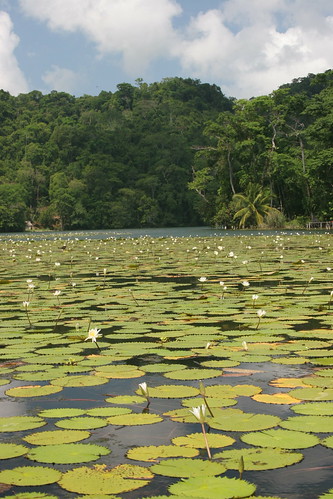
In my hurry to pack this morning I leave my flip flops under my bed. The 15 minute walk to the bus terminal with all my bags nearly kills me. We take a chicken bus and a slighter better bus to Rio Dulce on the banks of Lago de Izabal, Guatemala's largest lake. I'm relieved to arrive - it's been a hot and sticky day sat on buses. We're staying at Hacienda Tijax, a jungle lodge with basic cabins. The location overlooking the lake is stunning.
Friday, May 25, 2007
Lago de Atitlán, Guatemala
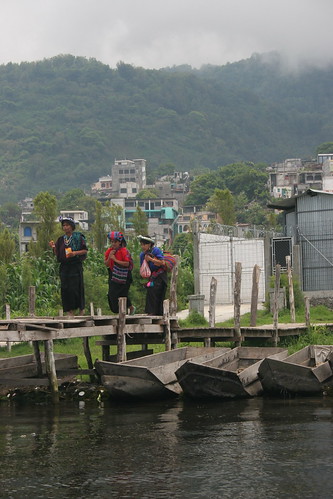
Our final stop on the lake is San Pedro La Laguna, where our tour leader's 85 year old grand other lives. We travel back to Antigua tonight arriving at 9pm. After a few drinks at Frida's Lori-Anne and I notice two guys following us closely down the street. We pick up our pace and as we turn the corner look back to see them stopped and searched by police.
Thursday, May 24, 2007
Santiago Atitlán, Guatemala

Back on the boat we stop at Santiago Atitlán, a similar village to San Antonio. Again we climb steep cobbled streets to visit a local deity known as San Simón or Maximón revered throughout the Guatemalan Highlands. Entering a local wooden house I can barely see the air is so thick with copal incense. When the air clears I see a short stout wooden effigy dressed in brightly coloured scarves, a hat and with a cigarette in his mouth. The room is filled with candles. Local people bring offerings such as alcohol, cigarettes, food, money etc. to ask for his blessing or a wish. While I'm there a ceremony is taking place. A local man has offered money in return for more business. I need to leave the room after a few minutes as I'm finding it hard to breath through the pungent air, not to mention close to being set alight by all the blazing candles.
San Antonio Palopó, Lago de Atitlán, Guatemala
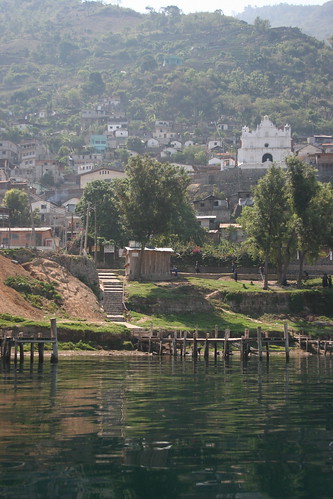
We catch a boat across the lake first to San Antonio de Palopó. It's misty and I can just see the outline of the volcanoes on the horizon. In San Antonio the steep cobbled roads wind their way up the hillside. It's not the easiest walk up the hill to the church where there are good views of the town and lake. We stop off at a weaving workshop where I buy some worry dolls. You're supposed to put these under your pillow, one doll for each worry you have, to prevent nightmares.
Monday, May 21, 2007
Iglesia de Santo Tomás, Chichicastenango, Guatemala
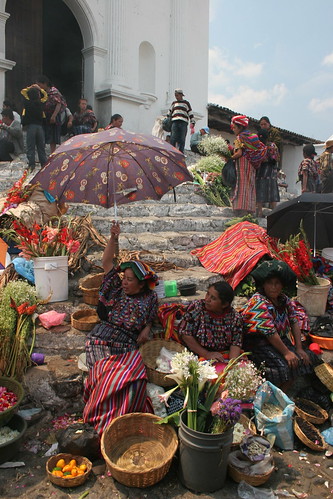
Iglesia de Santo Tomás is a simple elegant church standing in the midst of the market. Its steps are covered in offerings and smoulder with copal incense. Inside the aisles are strewn with candles, flowers and rose petals. It's breathtakingly beautiful. Photos are not allowed but it would have been difficult to capture the atmosphere of the place.
Chichicastenango, Guatemala
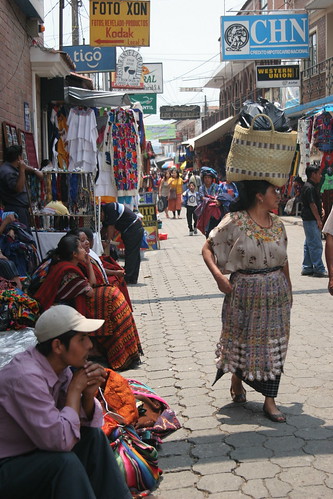
Chichicastenango or 'chichi' for short is a beautiful magical town with amazing Thursday and Sunday indigenous markets. Mayan traders from surrounding villages descend to sell colourful handicrafts including carved-wood masks, embroidered cloth and jewellery, as well as food, spices and goods for locals. Despite hordes of tourists it manages to retain a mystical air.
Lago de Atitlán, Guatemala
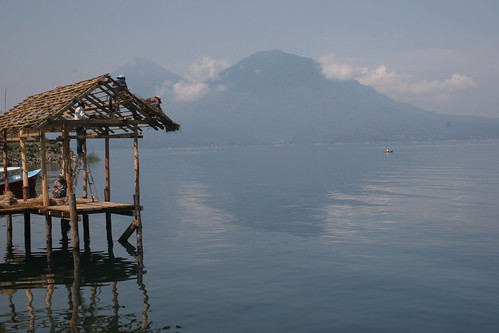
Following some sad goodbyes it's time to leave Antigua. I'm tired and sick (I threw up three times last night) and really can't face travelling on chicken buses today. I consider not going on, at least until I feel better, but somehow I manage to make it on to the first chicken bus. The guide tries to cheer me by asking me questions but all I want to do is sleep and listen to my ipod. Later in the day he says 'You were cranky today'. I could have punched him.
After four noisy chicken buses loaded with people (but no chickens) we arrive in Panajachel on the banks of the beautiful Lago de Atitlan. The lake is a caldera (collapsed volcanic cone), filled with shimmering blue water surrounded by three volcanoes. Panajachel, nicknamed 'Gringotenango' due to the number of foreigners here, is a shameless tourist trap consisting of a long dusty road with souvenir shops on either side selling similar tat.
Sunday, May 20, 2007
Fridas, Antigua, Guatemala
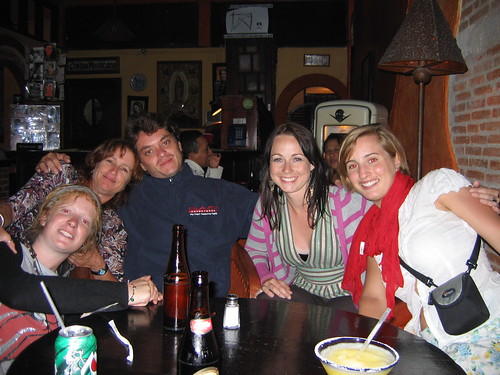
Oddly enough everything shuts down (bars, clubs etc.) in Antigua at 1am. We try to continue the festivities back at the hotel but an overzealous security guard tells us we need to go to bed. When I refuse he says he will report me. To whom I wonder.
From left to right: Gus, Chris, Deck (tour leader), Courtney & Charity
Iglesia y Convento de la Recolección, Antigua, Guatemala
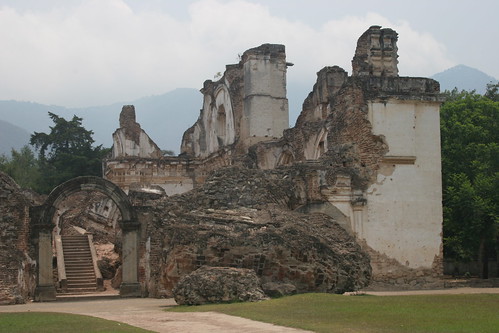
The amazing Iglesia y Convento de la Recolección ruins are among the most impressive in Antigua. Built between 1703 and 1708, it was reduced to rubble by the 1773 earthquake. To enter the site I climb over and through giant pieces of rubble.
At the entrance the guard says it's 30 quetzales each to enter. I tell him that Lori-Anne and I each paid 15 at San Jerónimo. He says ok and lets both of us enter for 30.
San Jerónimo ruins, Antigua, Guatemala
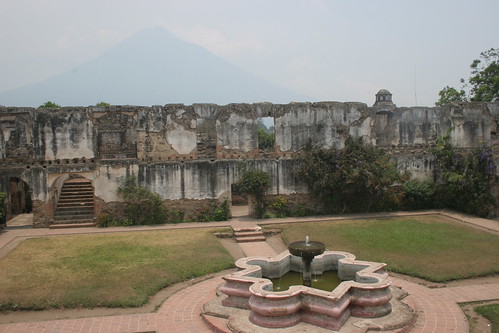
One of the recommended things to do in Antigua is climb the active Volcán Pacaya. But I'm not feeling well (not alcohol-induced this time) so decide to walk around some of the ruins scattered around Antigua.
San Jerónimo was built in 1757 by friars of the Merced order but was destroyed in the 1773 earthquake.
Antigua, Guatemala
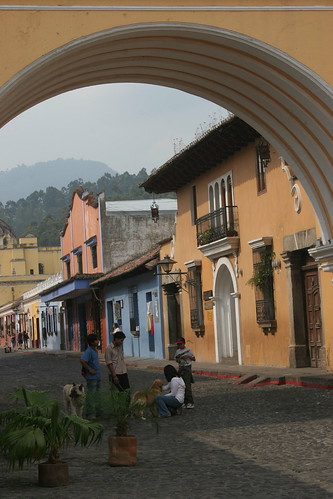
Six hours and an easy border crossing later we arrive in Antigua, Guatemala's old capital city until it was destroyed by an earthquake in 1773. Antigua is beautiful, possibly my favourite city in Central America (so far). Nestled between three volcanoes it has cobbled streets, painted houses and a leafy central square (Parque Central) surrounded by airy cafes and bars. I could easily spend a couple of weeks here. Not surprisingly many people feel the same way - Antigua is geared up for tourism with western-style eateries, souvenir shops and language schools.
Copán Ruins, Honduras
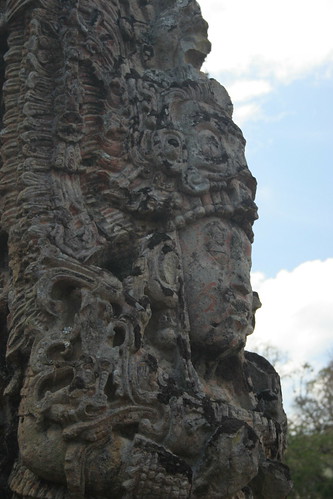
I'm not feeling well. It's a hot humid day and having drunk a bit too much (again) last night the last thing I feel like doing is trudging around ruins in the heat. But I do really want to see them as they're unique in their own way.
Copán Ruins are a Unesco world heritage site. As in many Mayan sites, archaeologists are still uncovering and restoring remains of structures that have been overgrown with vegetation.The remains of 3450 structures have been found in the 24 sq km surrounding the Principal Group of ruins, indicating that at the peak of the Mayan civilisation here, around the end of the 8th century, the valley of Copán had over 20,000 inhabitants.
The ball court (the second largest in Central America) and Hieroglyphic Stairway are both impressive but most impressive of all are the intricately carved stelae portraying the rulers of Copán which have been remarkable well-preserved.
(Photo - Stelae of the Great Plaza)
Copán Ruins, Honduras
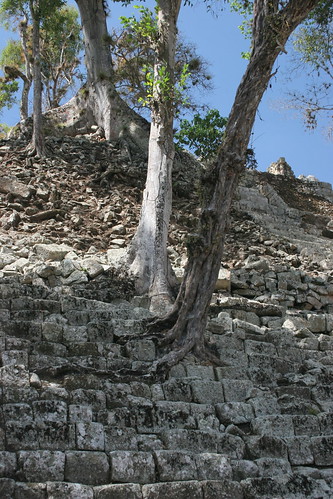
It's another absurdly early start to catch the 6am ferry back to the mainland. From La Ceiba a chicken bus takes us to the beautiful village of Copán where we arrive early evening. The hilly village, located about 1km from the famous Mayan ruins of the same name, has lovely cobblestone streets and white buildings with red-tile roofs.
(Photo - Copán Ruins)
Utila, Bay Islands, Honduras
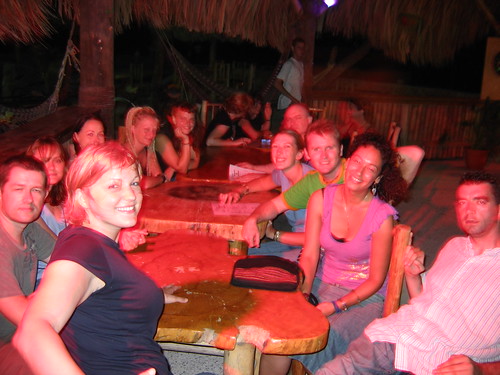
As we only have one full day in Utila most of us decide to dive or snorkel tomorrow, the only thing to do on the island apart from relax. Unwisely most of us drink far too much tonight (ending in Bar in the Bush reggae club) bringing on the most horrendous hangovers in the morning. Diving with a hangover is not the best idea I've ever had.
(Photo - dinner with the group. The camera shake adds to the ambience I feel)
Utila, Bay Islands, Honduras
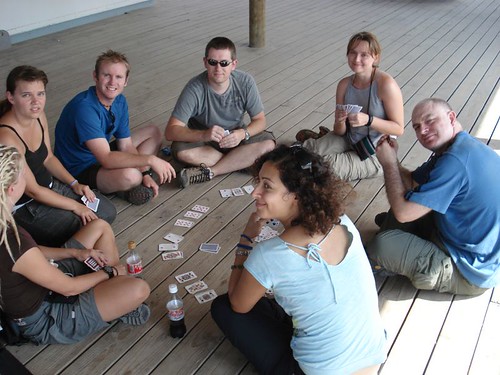
From León our next stop is the Bay Island of Utila in Honduras. It's a long way so after crossing the Honduran border, with surprisingly little trouble, and 9 hours of travel we stop for the night in Comayagua, a bland town with not much to see - hence no photos.
We travel for most of the next day to La Ceiba where we catch the 5pm ferry to Utila. It's a rough ride (and a wet one for those outside on deck) so it's a relief to finally arrive after nearly two days of travelling.
The laid back, almost trippy Bay Islands (the other island being Roatan) are renowned for great diving and snorkelling. The reefs are a continuation of the Belize reefs, the second largest in the world after Australia's Great Barrier Reef and are teeming with fish, coral, sea turtles and even whale sharks, if you're lucky.
(Photo - playing one of our many games of 'shithead' while waiting for the ferry to Utila)
Thursday, May 10, 2007
Subscribe to:
Posts (Atom)
